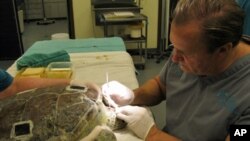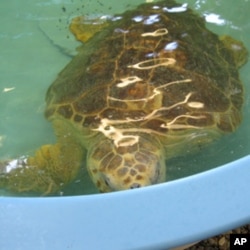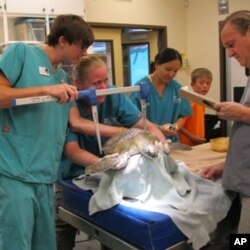This month, on beaches up and down the U.S. East Coast, tens of thousands of newly-hatched loggerhead sea turtles are emerging from the sand and crawling into the Atlantic. Very few of these baby turtles will survive, but a hospital in Georgia is trying to improve their chances.
Jekyll Island, Georgia, is best known as a summer vacation spot. But it’s also an important rehabilitation destination for hundreds of sick or injured sea turtles that wash up on Atlantic coast beaches each year.
“Twenty percent of the cases are boat strike-related injuries," says Terry Norton, a veterinarian who is director of the Georgia Sea Turtle Center. "We get fishing line and fishhook-related injuries. There’s a disease called fibropapilloma, caused by the herpes virus, that can cause tumors on the skin. We get some real debilitated turtles.”
Many have survived encounters with predators like sharks that can bite off a turtle’s flipper or crack its shell.
The operating room at the Georgia Sea Turtle Center looks like one you’d see at a major medical center for humans.
There are bright surgical lights, stainless steel tables and an x-ray machine. The doctors and nurses wear blue surgical scrubs. This morning, Norton is treating Ziva, a 68-kilo female loggerhead turtle.
“This is a turtle with a boat strike injury to the head and to her shell," he says. "She actually had a little abscess in the skull. These little Velcro patches are for putting weights because she floats asymmetrically so that helps her dive a little better and get around a little better.”
Norton estimates that Ziva is 10-to-12 years old, which is young for a turtle. He says rehabilitating these injured or sick juveniles is vital to maintaining the worldwide sea turtle population.
“They become sexually mature at 35 years of age. That makes it really significant when there’s adult mortality. It took a lot of turtles to reach that point. It takes about 4,000 hatchlings and eggs to get to that one animal, so all these mature animals are very important to the population.”
Unfortunately, Ziva’s injuries are so extensive that she’ll never recover enough to be released back into the ocean. Instead, she’ll go to an aquarium to become a turtle ambassador as part of an educational exhibit.
Since sea turtles are found worldwide, Norton’s staff works with conservation groups in India, Pakistan, Costa Rica and St. Kitts, teaching them how to protect and care for injured turtles.
Ten of thousands of the tourists who visit Jekyll Island each year come to the Georgia Sea Turtle Center to learn about the life cycle of turtles.
A highlight of their visit is the rehabilitation pavilion, where sea turtles, land turtles and even alligators can be seen recovering after their treatments.
“Out here they are all in quarantine areas…so since we are similar to a hospital setting, we try to keep as much under control as we can," says David Zailo, one of the center’s guides. "By separating the animals from one another, it’s easier to treat them. It’s easier to mark down what they feed and it's easier to mark down their progress as they’re healing.”
Visitors who really want to get close to turtles can join the center’s staff for an early morning turtle walk on a nearby protected stretch of beach.
Earlier this summer, dozens of female loggerheads - each about one meter in diameter - lumbered out of the ocean, dug nests in the sand and laid hundreds of eggs.
Now, those eggs are hatching and a lucky few visitors will get to see the baby loggerheads crawl across the beach and into the ocean, to begin their perilous journey to adulthood.


